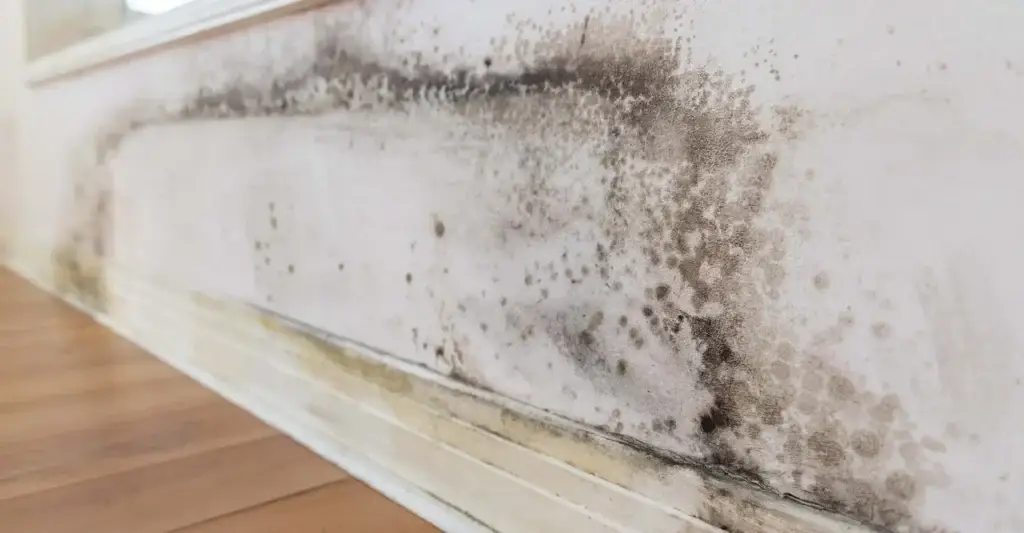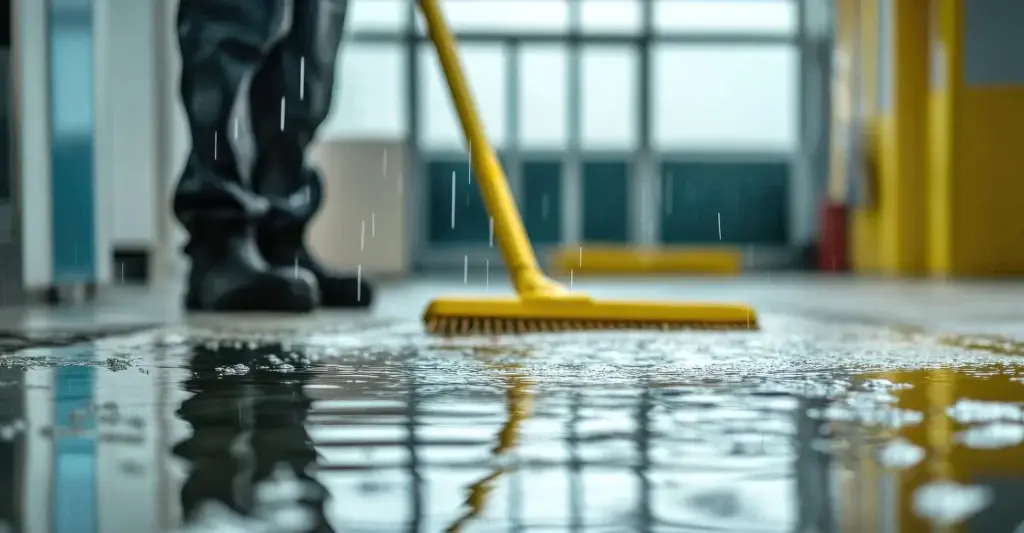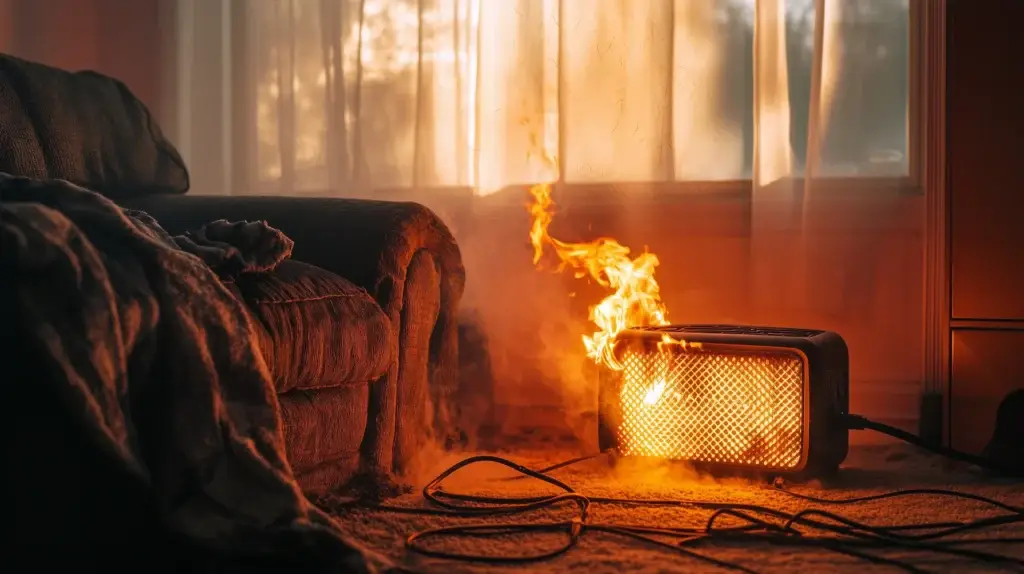Upon discovering water damage in your UK property, immediately prioritise safety by turning off electricity (if safe) and stopping the water source. Document all damage thoroughly with photos and videos for your insurer.
For anything more significant than a small, clean spill, professional water damage restoration is essential. Experts, like Ideal Response, provide specialised equipment for rapid water extraction, thorough drying (preventing mould growth which starts in 24-48 hours), and contamination control that DIY efforts cannot achieve. This ensures comprehensive recovery, addresses hidden moisture, protects structural integrity, and aids insurance compliance.
Skip to:
UK water damage and specialist response
Immediate steps after water damage
How much does UK water damage restoration cost?
UK water damage and specialist response
Discovering water damage in your home or commercial property can be an incredibly stressful and overwhelming experience. Whether it’s a slow leak that’s gone unnoticed, a burst pipe in the depths of winter, or the devastating aftermath of a severe storm, the immediate aftermath often leaves property owners asking: “What now? How bad is this, really? And how quickly can I get things back to normal?”.
At Ideal Response, we understand these anxieties. As specialists in comprehensive water damage restoration across the UK, we’ve helped countless homeowners and businesses navigate these challenging situations. This guide isn’t just about what we do; it’s about answering your most pressing questions, giving you clarity, and empowering you with the knowledge needed to make informed decisions when water strikes.
What should be my immediate steps after discovering water damage?
Your first reaction might be panic but acting quickly and methodically is crucial to mitigating further damage. Here’s a checklist of immediate actions:
- Safety first: Ensure everyone’s safety. If the water is near electrical outlets or appliances, turn off your main power supply at the fuse box if it’s safe to do so. If you suspect structural damage, evacuate the property.
- Stop the source: If possible, identify and stop the source of the water. This might involve turning off the main water supply valve to your property or temporarily patching a leaking pipe.
- Document everything: Before you touch anything, take photos and videos of the damage. This evidence is vital for your insurance claim. Document the water’s depth, affected areas, and damaged items.
- Contact your insurer: Notify your insurance company as soon as possible. They will guide you on their claims process and may recommend preferred contractors, though you always have the right to choose your own.
- Call a professional: For anything more than a small spill, contacting a professional water damage restoration company like Ideal Response is paramount. We have the expertise and equipment to handle the situation safely and effectively.
Can I handle water damage restoration myself, or do I really need professionals?
This is a common question, and the answer largely depends on the scale and nature of the water damage.
Small, Clean Water Spills (e.g., a knocked-over glass): For very minor incidents involving clean water (not contaminated), you might be able to manage the clean-up yourself with towels and a domestic fan.
Anything More Significant (especially with “grey” or “black” water): For burst pipes, leaking roofs, significant appliance failures, or any water that has touched the ground (especially from sewage or external flooding), professional intervention is not just recommended – it’s often essential. Here’s why:
- Hidden moisture: Water seeps into walls, under floors, and into cavities. Without professional damp survey equipment (like thermal imaging and hygrometers), you’ll miss hidden damp, leading to mould growth, structural rot, and ongoing health issues.
- Specialised drying: Domestic dehumidifiers are rarely powerful enough for significant water damage. Professionals use industrial-grade air movers and dehumidifiers, often tailored to specific humidity and temperature levels, for thorough and rapid drying.
- Contamination risks: Floodwaters, sewage backups, and even prolonged standing water from a clean source can quickly become contaminated with bacteria, viruses, and other pathogens. Professionals use appropriate PPE and sanitisation techniques.
- Mould prevention: Inadequate drying creates perfect conditions for mould. Professionals not only dry but also apply antimicrobial treatments to inhibit mould growth.
- Structural integrity: Water can compromise the structural integrity of your property. Experts assess this risk and can advise on necessary repairs.
- Insurance compliance: Many insurance policies require professional mitigation to ensure the claim is valid and full restoration is achieved.
Ultimately, while DIY might seem cheaper upfront, the potential for long-term damage, health risks, and costly secondary repairs often makes professional water damage restoration the most cost-effective and safest choice.
How much does water damage restoration cost in the UK?
‘What will this cost?’ is often the next burning question. Providing an exact figure without an assessment is impossible, as the cost of water damage restoration in the UK varies significantly based on several factors:
- Category of Water:
- Category 1 (Clean water): From burst pipes, overflowing sinks, etc. Least costly to remediate.
- Category 2 (Grey water): From dishwashers, washing machines, or toilet overflows (without faeces). Contains contaminants and requires more specialised cleaning.
- Category 3 (Black water): From sewage, river floods, or long-standing grey water. Highly contaminated and requires extensive sanitisation and removal of porous materials. This is the most expensive to remediate due to health risks.
- Scope of damage: How many rooms are affected? Is it just flooring, or have walls, ceilings, and contents also been damaged?
- Materials affected: Different materials (e.g., plasterboard, concrete, hardwood, carpet) require different drying techniques and can vary in replacement cost.
- Duration of exposure: The longer water sits, the deeper it penetrates, and the higher the risk of mould, increasing restoration time and cost.
- Accessibility: Is the damaged area easily accessible, or does it require demolition to reach?
- Labour & equipment: The size of the team and the type of industrial drying equipment required (dehumidifiers, air movers, desiccant dryers) will influence the cost.
- Additional services: Does the job require mould remediation, odour removal, content cleaning, or structural repairs?
Ideal Response provides transparent quotes after a thorough on-site assessment. We work with you and your insurer to ensure a clear understanding of the costs involved.
What does the water damage restoration process typically involve?
While every situation is unique, a professional water damage restoration process generally follows these key steps:
- Emergency contact & assessment: Our 24/7 team responds rapidly, conducting a detailed assessment using advanced tools to determine the extent of moisture penetration.
- Water extraction: High-powered pumps and wet-vacs are used to remove standing water quickly.
- Drying & dehumidification: Industrial-grade air movers and dehumidifiers are strategically placed to accelerate evaporation and remove moisture from structural materials and the air.
- Cleaning & sanitisation: All affected surfaces are cleaned, disinfected, and deodorised to prevent mould growth and eliminate contaminants.
- Restoration & repairs: This final stage involves repairing or replacing damaged materials like flooring, plasterboard, or insulation, bringing your property back to its pre-damage condition.
- Monitoring: Throughout the process, our technicians continuously monitor moisture levels to ensure complete dryness.
How long does water damage restoration take?
The timeline for water damage restoration varies significantly. A small clean water spill might take a few days to dry and restore, while extensive flooding involving multiple rooms and contaminated water could take weeks, or even months, especially if structural repairs are needed. Factors like humidity levels, the type of materials affected, and the efficiency of the drying equipment all play a role. We will provide an estimated timeline during our initial assessment.
Will my insurance cover water damage restoration?
Most standard home and commercial insurance policies in the UK include coverage for sudden and accidental water damage (e.g., burst pipes, appliance leaks). However, damage caused by negligence, maintenance issues, or external flooding (unless you have specific flood insurance) might not be covered. It’s crucial to review your policy details and discuss your situation directly with your insurer. Ideal Response has extensive experience working with insurance companies and can help streamline the process.
How can I prevent future water damage?
While some incidents are unavoidable, many can be prevented:
- Regular maintenance: Inspect pipes, appliances (washing machines, dishwashers, water heaters), and roofing annually.
- Know your stopcock: Locate your main water shut-off valve and ensure everyone in the household knows how to use it.
- Gutter & downspout care: Keep gutters clear of debris to ensure proper drainage away from your foundation.
- Basement/crawl space checks: Regularly inspect for signs of moisture or leaks.
- Insulate pipes: Protect pipes in unheated areas (lofts, basements) from freezing in winter.
- Water detection alarms: Consider installing smart water sensors that alert you to leaks early.
Conclusion: Seek professional help
Water damage is a serious issue that demands a professional response. By understanding the immediate steps, the risks involved, and the professional process, you’re better equipped to protect your property.
If you’re dealing with water damage in your UK home or commercial property, don’t hesitate. Ideal Response is available 24/7, ready to provide rapid, expert water damage restoration services. Call us today for a swift assessment and to begin the restoration process, getting your property back to normal quickly and efficiently. Or you can visit our service page to learn more about our process and the benefits the water restoration service provides.
Need to speak to a specialist urgently? Call 01622 926 505
UK Water damage restoration: Frequently asked questions
What are the immediate steps I should take after discovering water damage?
Upon discovering water damage, your absolute first step is to prioritise safety:
Turn off your power at the fuse box if the water is near electrical outlets.
Stop the water source by turning off your home’s main water valve or repairing a leak if safe.
Document everything with photos and videos for your insurance claim.
Contact your insurer to report the damage and begin the claims process.
Can I handle water damage restoration myself, or do I need a professional?
For anything more significant than a small, clean spill, professional restoration is essential. Professionals have specialised equipment to detect hidden moisture in walls and floors, which prevents mould growth (starting in 24-48 hours). They also safely handle contaminated water and ensure the property is thoroughly dried and sanitised, which is crucial for structural integrity and health.
How much does water damage restoration cost in the UK?
The cost of water damage restoration in the UK is highly variable, as it depends on several key factors:
Water category (clean, grey, or black/sewage).
Extent of damage and size of the affected area.
Type of materials impacted (e.g., carpet vs. concrete).
Duration of water exposure, which increases the risk of mould and structural damage. A professional assessment is required for an accurate quotation.
How long does water damage restoration take?
The timeline varies significantly. A small spill might take a few days to dry, while extensive damage involving multiple rooms and contaminated water can take several weeks to months. The duration depends on the severity of the flood, ambient humidity levels, and the type of materials that need drying.
Will my home insurance cover water damage restoration?
Most standard UK home insurance policies cover sudden and accidental water damage (e.g., burst pipes, appliance leaks). However, policies often exclude damage caused by negligence, lack of maintenance, or external flooding unless you have specific flood insurance. You should review your policy details and discuss the situation with your insurer.
What does the professional water damage restoration process involve?
The process generally follows a structured plan:
Emergency Contact & Assessment: A professional team responds rapidly to assess the damage.
Water Extraction: High-powered pumps remove standing water.
Drying & Dehumidification: Industrial-grade equipment dries the area and removes moisture from the air and structures.
Cleaning & Sanitisation: All surfaces are cleaned, disinfected, and deodorised to prevent mould.
Restoration & Repairs: Damaged materials like flooring or plasterboard are repaired or replaced to restore the property.
How can I prevent future water damage in my home?
You can prevent many incidents by:
Regularly inspecting pipes, appliances, and roofing for leaks.
Knowing the location of and how to use your main stopcock.
Keeping gutters and downspouts clear to direct water away from your foundation.
Insulating pipes in unheated areas to prevent freezing.
Considering the installation of water detection alarms.

Tahlia Ibrahim - Delivery Manager
Tahlia has over four and a half years of in-depth experience across various facets of the disaster recovery industry. Having progressed through roles in marketing and sales to her current position, Tahlia possesses a comprehensive understanding of the entire business operation, from initial client contact to meticulous service delivery. A certified BioSweep Specialist, she excels in advanced odour elimination techniques, ensuring thorough restoration.





















